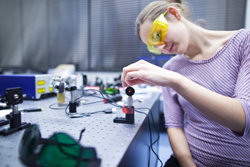Controlling crystal growth for better glass materials
Glass containing metallic nanoparticles is piquing interest for potential applications in photonics thanks to their special linear and non-linear optical properties. These properties are determined by surface plasma oscillations of the metal clusters, the resonance of which is strongly linked to the concentration, distribution and shape of the nanoparticles. Another important factor is the surrounding dielectric matrix, which influences the movement of electric and magnetic energy. Optimising glass materials by manipulating nanostructural properties promises to facilitate the development and production of non-linear materials, nanodevices and optical elements. One way of doing this is with laser-based techniques that can modify the shape and size of the metal clusters; this has already been proved to be a powerful and flexible tool for controlling and optimising linear and non-linear optical properties of composite materials. It can be realised by engineering the material's optical properties through gaining control of the distribution of nanoparticles in the glass matrix. Researchers are now considering the femtosecond laser (FSL), to take advantage of this potential. the 'Femtosecond laser induced nanoclusters in glasses for photonic applications' (Femtonano) project aimed to advance knowledge in this area by studying light-matter interaction and, in particular, the multiphotons processes. This is essential for efforts to develop new optical devices based on the mastering of nanoparticles. The EU-funded project set out to better understand how metallic nanostructures form in glassy media as well as find a way to manipulate the nanocluster shape and distribution within the dielectric matrix. FS pulses have much to offer in the way of space-selective microscopic processing and formation of three-dimensional modified microstructures. FSL processing has already been used for the manufacture of various kinds of integrated functional opto-devices. These include 3D optical waveguides, optical memory and photonic crystals. in their investigations of FSL-induced nanoclusters in glasses for photonic applications, team members were able to propose a possible mechanism for nanoclusters shaping and understand more about the influence of laser irradiation conditions on the behaviours of these nanoclusters. Experiments revealed the stress fields induced by FSL irradiation and enabled researchers to describe effects of varying intensity and writing direction. femtonano successfully used FSL irradiation to write crystalline lines inside multi-component silica glass and identify the laser processing windows and composition of the glass host matrix. The crystallisation technique sets the foundation for efforts directed at achieving 3D optical memories, integrated solid-state displays and perhaps even integrated optic-electronic devices. A definition showing how to achieve easy control of crystal growth orientation inside glasses is still lacking. Femtonano partners intended to continue efforts in this direction even beyond the scope of this project.







